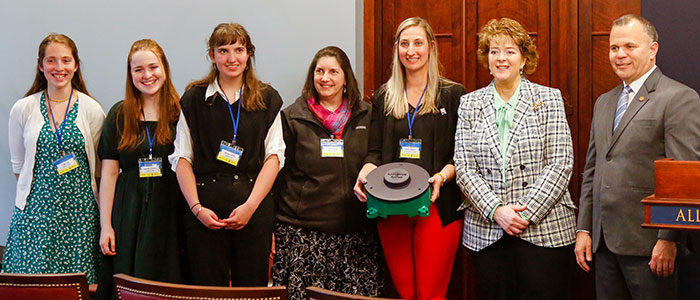Sen. Brooks, Allegheny College and ESU Join Forces to Take on Tickborne Diseases through Local Tick Mitigation Study

Posted by: admin on April 26, 2022, No Comments
Among those in attendance at today’s press conference to announce funding for the collaborative tick mitigation study are, from left: Lillian Noel ’23 and Joanna Houston ’23, Global Health Studies majors at Allegheny; Ashlynn Peachey ’23, student intern majoring in Global Health Studies at Allegheny College; Caryl Waggett, professor and founding chair, Global Health Studies, Allegheny College; Nicole Chinnici, director, PA Tick Research Lab and Dr. Jane Huffman Wildlife Genetics Institute at East Stroudsburg University; Senator Michele Brooks; and, Kevin Kovalycsik, chief of staff, Allegheny College.
As the state with the highest number of Lyme disease cases in the nation, Sen. Michele Brooks has been committed to making inroads as Pennsylvania combats a surging tick population and works to increase awareness of testing, diagnosis and treatment of tickborne diseases.
As infection rates reach crisis levels, Brooks has been consulting and collaborating with the Pennsylvania Tick Research Lab at East Stroudsburg University (ESU), and now with Allegheny College, to develop a pioneering new strategy to attack Lyme and other tickborne diseases at the source: the growing tick population, and the carriers who transport ticks.
“I strongly believe that tick-related diseases are at a crisis point here in Pennsylvania, and I will continue to lead the charge for the Commonwealth to take a more aggressive role in combatting this crisis. The solution must be multi-faceted and must include reducing the tick population, combatting the transfer of tick-related diseases, and providing broader insurance coverage for both testing and treatments.”
“This partnership with East Stroudsburg University and Allegheny College is one innovative tool that can help bring us closer to identifying how to reduce the tick population and reduce the transmission of tick-related disease,” Brooks added.
Brooks was joined by researchers from ESU, academic leaders, and Allegheny College students and staff as they unveiled the official launch of their efforts today at Allegheny College in Meadville, which has been selected as one of 12 sites in a new multi-year tick mitigation study.
Brooks has secured state funding for this project, which will be conducted in Crawford and Mercer Counties, along with Bucks, Lehigh, Monroe, and Pike Counties.
Nicole Chinnici, Director of the Pennsylvania Tick Research Lab at ESU, said this project is vital because “Ticks and tickborne illnesses have been affecting residents of Pennsylvania for decades. This funding will allow our researchers to evaluate the use of tick mitigation strategies in reducing tick and tickborne illnesses in three regions of Pennsylvania, including the northwest. We are excited to be on the cutting edge of new research with the goal of finding the most effective strategy for reducing tick populations.”
“I want to thank Senator Brooks and other legislators who have placed an emphasis on the value of tick education and prevention for our neighbors across the state and the country,” said ESU Interim President Kenneth Long. “This new funding source made available by Senator Brooks will enable the PA Tick Lab to branch out into new areas of research and development aimed at minimizing the transmission of tick-borne illness and disease. This collaboration positions us to build a healthier experience for those who enjoy exploring the great outdoors.”
The study will require a research technician to drag the wood line area with a corduroy cloth to collect ticks that may be in the area. The technician will then set live mouse traps 10 meters into the wood line. These live traps will be in place for three days every 12 weeks until the end of the project. Blood samples will be taken from mice and ticks removed to monitor infection of tickborne illnesses. It’s important to note that no mice are hurt in this process, and traps used do not produce a scent and will not attract additional mice to the area, according to project researchers.
The research technician will place two bait boxes every half acre, or approximately one box per property, with materials that will enable the technician to vaccinate mice against ticks, which will also kill the ticks.
Brooks and Chinnici encouraged anyone who has removed a tick from themselves or a loved one to place it in a plastic bag and send it free of charge for testing to the PA Tick Research Lab at ESU. The mailing instructions can be found at www.Ticklab.org. The testing is paid for through funds secured by Senator Brooks and Representative Rosemary Brown to create a partnership between ESU and the PA Department of Health. The funding also helped with the development of a data analytic website to track tick infection rates across the Commonwealth.
Brooks has also introduced a three-bill package to address Lyme and other tickborne diseases, by focusing on targeted education of medical professionals, informing parents when their children have a tick removed from them during school hours, and providing for insurance coverage for doctor-recommended treatments.
Dr. Caryl Waggett, Professor at Allegheny College, said, “The ecology of these tickborne diseases is highly complex, involving the pathogen, the vector tick, wildlife hosts and humans. The research is both timely and valuable for residents in our communities, but also in training teams of interdisciplinary student researchers as future scientists, medical practitioners, public health professionals, and regional planners able to address other emerging and re-remerging diseases in Pennsylvania’s ever-changing climate.”
“I am deeply grateful for Senator Brooks’ strong support for improving the health of Pennsylvanians and for connecting such like-minded institutions together on this project,” Waggett added. “And I am very proud to be able to work with such talented students and colleagues at both East Stroudsburg and Allegheny on this research to understand and potentially reduce risks from these vector-borne diseases.”
Search
Recent Posts

Julianna and Wayne Bolt Art Contest Winners Selected for the 29th Annual Martin Luther King Jr. Celebration
December 10, 2025 - Read more

ESU Hosts 8th Annual Dr. Barbara G. Collins Social Work Professional Development Day
December 4, 2025 - Read more

ESU Professor Elected to American Society of Plant Biologists Steering Committee
November 25, 2025 - Read more

ESU Women’s Rugby Club Team Headed Back to Division III National Championships
November 25, 2025 - Read more
